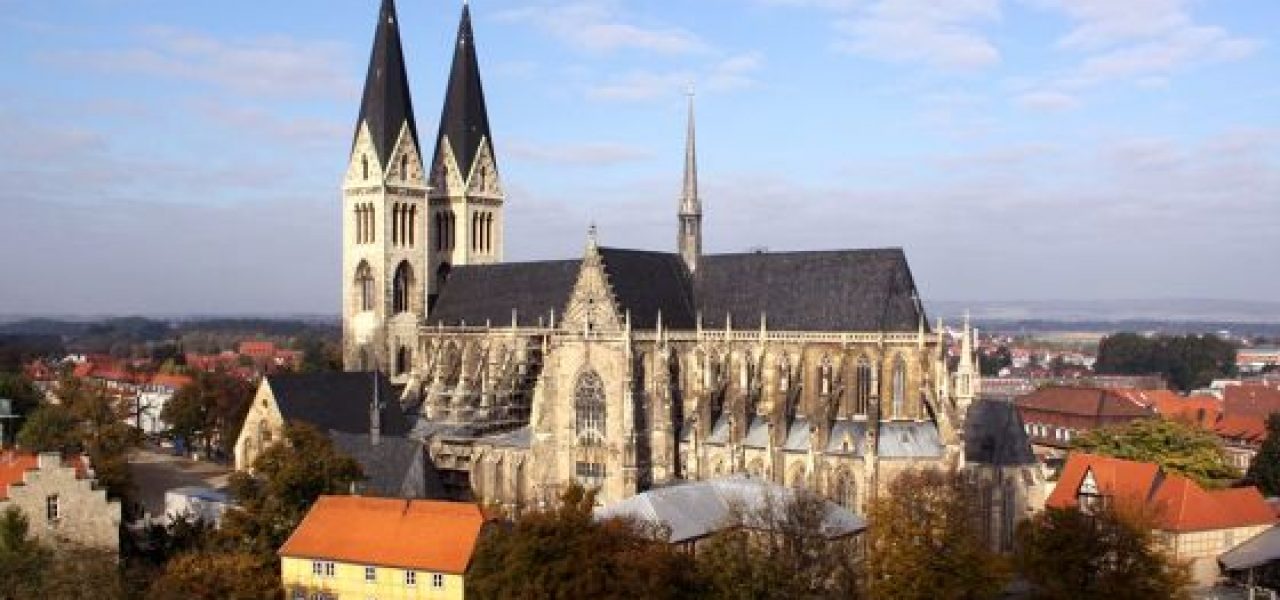INTRODUCTION
A number of romanesque churches was taken over in the Halberstadt area, in the first place the Collegiate Church of Our Lady and the Benedictine Monastery of Huysburg.
HISTORY
St. Stephen’s Cathedral was built between 1236 and 1486 along the lines of French cathedrals. 290 medieval glass paintings glow in the windows of the cathedral choir. The most important piece of equipment is the monumental larger-than-life triumphal cross group, which was created around 1220 as a masterpiece of medieval carvers. An exceptionally large number of medieval works of art can be found not only in the cathedral, but also in the cathedral treasury which counts the most precious ensembles of Middle Age artwork.
Smaller stone buildings served as the first bishops’ churches, followed by a new Carolingian building, consecrated in 859, as a three-aisled cruciform basilica. This cathedral collapsed in 965. The construction of the Ottonian Cathedral began immediately afterwards, and was consecrated in 992 and almost reached the size of the later Gothic new building. The (Ottonian) cathedral was badly damaged in the course of the destruction of the city in 1179 by Henry the Lion, but was then quickly restored and vaulted and had been consecrated again in 1220.
Afterwards the successive construction of a “modern” Gothic cathedral, which started unusually with the west building, began. The western building combines the local late Romanesque building tradition with the modern early Gothic influences, especially the architecture of the Cistercians. The construction of the high Gothic nave began around 1260, the dimensions – probably as a competitor to Magdeburg – was significantly increased compared to the original planning. The central nave reached the impressive height of 27.0m at that time, the side aisles are 14.0m high. The entire cathedral was consecrated in 1491. As the last late Gothic addition, the new chapter room was completed in 1514 and in 1516 the bronze chandelier in the central nave was added.
Due to World War II, April 8th in 1945 finally brought the fall of the old Halberstadt with its over a thousand preserved half-timbered houses. The cathedral was also hit hard by twelve bombs. While the old town was largely left to decay after the war, the “GDR (German Democratic Republic) Monument Preservation” took extensive measures to secure and restore the large Gothic cathedral.
ARCHITECTURE AND FURNITURE
The Cathedral is not only one of the most important buildings of the Road of the Romanesque in Saxony-Anhalt due to its impressive architecture. It also houses one of the most valuable church treasures in the world. More than 650 objects of medieval art have been preserved and testify to their former splendor. At the heart of the treasure is a chip from the cross of Christ, which Konrad von Krosigk brought from Constantinople from the fourth crusade. The unique monumental tapestries, the “Abraham Engel Carpet” and the “Christ Apostle Carpet” are extremely impressive. They illustrate the biblical story. Liturgical church utensils, vessels and vestments as well as goldsmith and ivory works also count among the cathedral treasures. A Byzantine bread bowl from the 11th century, sculptures and altarpieces are particularly impressive. Since 2008, 300 exhibits can be viewed in the permanent exhibition in the historic rooms of the cathedral
OPENING HOURS
Monday and Tuesday – closed
Wednesday to Sunday and public holidays
10.00am – 11.30am
12.30pm – 2.00pm
3.00pm – 4.30pm
CONTACT
Domschatz Halberstadt
Domplatz 16a
38820 Halberstadt
Telephone: +49 3941 24237
Fax: +49 3941 621293
E-Mail: :domschatz-halberstadt@kulturstiftung-st.de
Website: www.dom-schatz-halberstadt.de
ENTRANCE FEES & GUIDED TOURS
Adults & seniors EUR 8,00
Reduced* EUR 6,00
Children and adolescents up to their 18th birthday – free entry
* The following are deemed to be reduced: students, trainees, the severely injured and job seekers upon presentation of a credential
ROUTE SUGGESTIONS
TOURIST INFORMATION OFFICE
Romanesque Art Centre
Domplatz 1b
39104 Magdeburg
Phone: +49 391 838 0222
E-Mail: Info@haus-der-romanik.de
Website: www.haus-der-romanik.de


